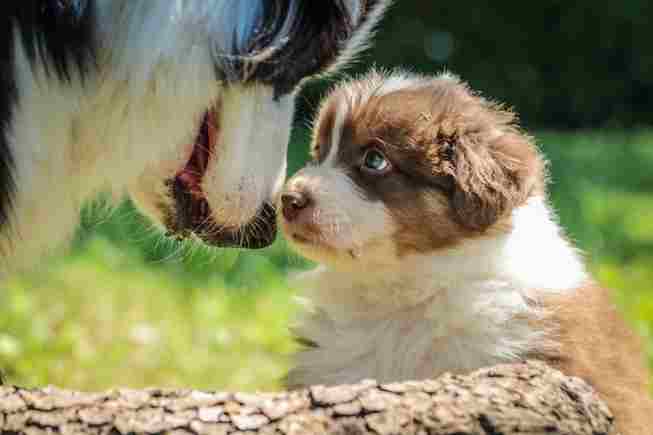Crate training could be the next big decision after bringing home a new puppy; Knowing the benefits of the crate training for your dog eventual home training and providing a safe place where the puppy can relax; The logical question would be When to start crate training the puppy?
You want to start crate training your puppy as soon as you possibly can. The sooner you start crate training the easier it is to do it effectively. When a puppy is at his new home, he has to adapt to new things, so you want to use that adaptation phase to start crate training and that will help with the rest of the home training including potting training.
I have been crate training my dogs for years and I found that the best results I got are with puppies I started crate training as soon as I got them home.
Can you crate train an 8 week old puppy?
Usually, this is the minimum recommended age to take a new puppy home. However, you may have some doubts about the new puppy’s ability to handle crate training.
Not only younger puppies are able to handle crate training, but the younger the puppy is the more receptive he will be.
The habits and behavior acquired at a very young age are more likely to stick with the puppy during adulthood.
As I mentioned in my introduction to the subject; The best results I had were with younger puppies.
Using that transition phase to establish a solid crate training is the smart move.
Potential issues to crate training at a young age
There are two major issues to deal with when crate training a young puppy.
Potting incidents and breaks
The young puppy has little control over his bladder. This will increase the number of potting breaks, especially during the night.
Young puppies are more likely to have potting incidents than older dogs.
Fortunately, it doesn’t take the puppy long to have better control over his bladder.
I personally wouldn’t think of the potting training as an issue when crate training. In fact, crate training helps tremendously with potting training.
The only confusing thing about potty breaks is to identify one when the puppy is whining in his crate at night.
I have written a post about dealing with the puppy whining in the crate and how you can pinpoint when the puppy is whining for a potting break; make sure to check the article it could be very helpful.
The transition phase

Indeed the transition phase can be difficult for a new puppy, making it harder for you. However, this could be an opportunity to establish a good foundation for your training.
The new puppy always misses his mommy and siblings who were his whole world for his short life.
There could and probably will be some whining in the first few nights; This is not impossible to deal with though.
I would recommend you check out my article on crate training a puppy first night. You can find useful tips to go through that first night.
Why you should start crate training puppies at a young age
In her article for vcahospitals; Dr. Debra Horwitz states that “some training can begin as soon as the puppy can open its eyes and walk”.
This can’t be more accurate, indeed starting at a younger age is by my own experience way easier.
You may have heard some dog trainers promoting training at six months; That is such a juvenile age where the dog is less likely to listen to you, and every single thing you want to train them to do will be a battle.
Breaking old habits
When crate training an older puppy, you’re not only teaching new rules and commands to follow. You are also breaking old habits that the puppy may have acquired before his training.
You can clearly see that this is a double process that takes more time. Just like you can’t leave your son until he reaches teenage years to start teaching him manners, the same thing can be applied to your puppy.
Resistance to change
Just like i’ve been tough in business school, new employees are less likely to show resistance to change in their work environment(new methods, new software …) than older employees.
I think this applies to pretty much anything. The longer we are used to something the harder it is to make a change.
If your dog is used to sleeping in an open room, for instance, it will be harder to make him switch to sleeping in a crate.
On the contrary, if the young puppy has never tried sleeping elsewhere, he is less likely to show any resistance.
Benefits of crate training at a young age
There are multiple benefits to crate training your puppy at a younger age; here are some of the most obvious.
Stability

Like us, dogs do like to feel some sort of stability and have their own routine.
If you make a significant change to your dog’s daily routine, you will start noticing behavior issues soon enough.
Some dogs may experience potting disorders even at adulthood due simply to changes in their routine.
When you make the foundation of a healthy routine at the start for your puppy, you are giving a huge boost to his positive personality in the future.
Potty training
The crate training regulates the potting breaks and walks for your puppy helping you achieve great progress in his training.
Being in the crate motivates the puppy to control his bladder more; meaning that dogs being fairly clean animals will not urinate in an area where they sit and relax.
However, to make it clear this does not mean you should make your puppy hold it for longer periods. This could result in health issues for the puppy.
The very fact that the puppy is in the crate he will automatically let you know he needs a potty break rather than just go for it whenever he is and just moves to another area.
Communication

The first few weeks are very important for establishing communication with your puppy.
The fact that the puppy has to let you know he needs a break for potting or anything else is a huge boost in communication.
It emphasizes the fact that he has to communicate to get what he wants; Sure this early communication is sometimes as basic as whining but still, the idea is there.
When to start crate training a rescue puppy
If you’ve chosen to adopt a rescue puppy that is probably older, you may be wondering when to start crating your puppy. Of course, a rescue dog is different and may have been through some bad experiences.
The first thing I would recommend is to get as much information when possible about the rescue puppy from the shelter.
Having some insight about what the rescue puppy has been through may help you ease the process of crate training.
You can avoid some situation that could scare the puppy or remind him of a bad experience.
A puppy that has been confined with no attention to his needs may develop resistance to the crate for instance, and you may need longer baby steps to introduce him to the crate.
You can have some more insights on how to crate train a rescue dog by reading my explicit guide to crate training.
Why is it important to start crate training a rescue puppy once you had him?
The very purpose of the crate is why you should start crate training the rescue puppy as soon as possible; in order to avoid anything that could freak out the puppy.
Rescue dogs often have safety issues, once that covered they are almost like any regular puppy out there; That’s when crate come in. A crate is a safe place where the puppy feels safe and can relax.
Rescue dogs often have trust and safety issues, so the crate training won’t be easy. However, the crate training will make the whole training process a lot easier and faster.
Once you lay down the foundation for a safe den where the puppy feels secure you can teach him anything.
How to start crate training your puppy
I am not going into full details about crate training steps as this is not our topic. However, I want to make a few important general points you should consider, for more details check out our crate training guide.
Start slow
You want to start with baby steps don’t rush your puppy into the crate with no introductions.
Use the treats and verbal praise to lure the puppy into the crate and make sure only good things happen in the crate.
You want the puppy to feel the safety of the crate and enjoy his time in it.
Make the crate a happy place by associating it with happy events; feeding and toys and treats and verbal praise are all great tools.
Avoid the yelling
You want to avoid the yelling when training your dog, especially around the crate to keep it a happy place.
Don’t force the puppy into the crate let him explore it. the puppy must not feel trapped in there.
Don’t reprimand the puppy in case of resistance, instead use rewards and treats.






